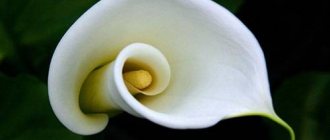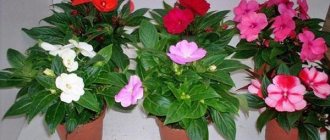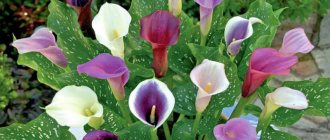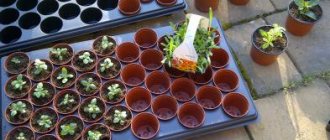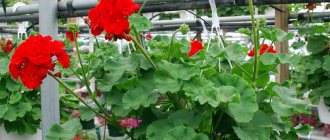Decorative deciduous and flowering begonias can decorate any room from spring to autumn with their elegant leaves and beautiful flowers. But as soon as late autumn, closer to winter, the days become short and the heating is turned on in the apartments, the plants begin to suffer. Due to lack of lighting, they stretch out, and due to dry air, the leaves turn yellow and dry out. What to do, how to care for indoor begonia in the fall and winter at home, so that in the spring the flower will again delight you with its beautiful leaves and lush flowering, learn from our article.
Features of winter care
In the first year, begonia tubers are small and weak. Therefore, they require special care. There is a risk of death of young rhizomes if they are left in storage with adult specimens.
- Young plants are removed from the beds in the fall and placed together with a ball of soil in boxes with a peat mixture. For first-year begonias, the state of rest is relative. In winter, their upper part remains green. Containers with flowers are placed in a bright and cool place. It is recommended to moisten the soil once every 2 months.
- In adult flowers, the lower part dies off by autumn. It is cut off, the roots are dug up, and placed in boxes with sawdust, peat or sand. Planting rhizomes are kept in a cool place until spring in the refrigerator or in the basement.
It is not recommended to store tubers in the cellar due to high humidity . This has a very negative effect on plants.
How to prepare tuberous begonia for winter
This plant is heat-loving and does not overwinter in open ground or in tubs outside in cold weather. If the begonia grew in the garden, it needs to be dug up, if in pots, it needs to be moved indoors until March.
Preparation for winter comes down to the following steps:
- Reduce watering.
- Trimming dead above-ground parts of the plant.
- Transfer the tubers to a cool, dark, ventilated place for the winter.
- Caring for tuberous begonia during the dormant period before spring planting.
Caring for tubers dug up from the garden in the fall and a plant that has been blooming outside in pots all summer is necessary in the same way.
Important! You need to dig up the tubers after trimming the dead green part. Leave a lump of earth and do not shake off the soil from the root. Reproduction and division can be done by spring before planting. You don’t have to leave small tubers, they will dry out over the winter; select only large, healthy ones .
Digging up tuberous begonia
With the arrival of frost, the flower has already completely withered and it is time to prune it. By leaving a couple of centimeters of the stem, in the spring you will be able to understand where the top part of the tuber is, so that you can plant it correctly. You should dig with a clod of earth so as not to destroy the rhizome and all growth.
It is worth considering that a large plant, 2 years old or more, can be kept in the ground longer. If the flower has bloomed for the first season, it is better to dig it up early with a large lump of soil.
Experienced flower growers also do not advise leaving grown small tubers up to 2 cm in diameter, as they will not survive the winter and will draw juices from the mother root.
The dug up tubers with a lump should be placed in boxes and moved under a canopy to protect from rain. Water occasionally and little, once every 2 weeks. You can move it to the basement, the temperature should be about 15 degrees.
If you dig up young tubers at the beginning of autumn, you can keep them in boxes, protected from rain and sun, for about 1 month, until the above-ground part dies off. After this, cut off the stems. If you dig up an adult flower in November, then immediately transfer it to a basement, cellar or outdoor greenhouse for winter storage. At the same time, protect from light.
2 weeks after pruning the tubers, they need to be cleared of soil and transplanted into containers with sand or peat and transferred to a dry, dark and cool place for storage throughout the winter.
To keep the roots alive during the winter dormancy period, it is necessary to place them in a dry sand-peat mixture and provide the correct temperature and humidity. You cannot overdry or over-moisten the tubers; this will cause them to die.
Important! In open ground, mature begonia does not need to be dug up before frost, since in the fall the rhizome gains strength and increases mass. Some experts wait until early November.
Rest period and awakening
Dormancy or wintering for tuberous begonias begins in November and continues until early March. The florist must take care of the planting material: preserve it and prevent it from drying out. To do this, certain rules are followed:
- Begonias should not be retired at the beginning of autumn. To prepare for wintering, they must gain enough nutrients.
- Tubers need to be dug up at the end of October - beginning of November (before the onset of serious frosts).
At the end of March - beginning of April, the buds sprout and the begonia awakens. This is the right time to take cuttings and plant a plant:
- 2 months before planting, the tubers are removed from the container in which they overwintered and placed in a container for germination.
- The roots are planted with the crown up.
- The tubers are germinated in a room with a temperature of at least +18 degrees.
- Water daily. Sprouts will appear within a few weeks.
- Before planting, you can separate the tubers. There must be buds on each half. The cut areas are sprinkled with coal powder.
- Sprouted begonias are placed on the beds no earlier than the beginning of June. Choose a place well protected from direct sunlight and wind.
Why do you need to prepare in the fall?
Begonia is an ornamental flower grown both outdoors and at home.
Reference. From the beginning of November until the last days of February, the plant falls into a dormant state, in which it regains its strength after the end of the growing season.
Dormant period and awakening of tubers
If you do not follow the rules for storing tuberous begonia in winter, then in the spring, due to the insufficient number of buds laid by the tubers, the plant will bloom poorly. To preserve a perennial, you must adhere to a number of rules:
- Young bulbs grown from seeds require a cool place, moderate light and infrequent watering. It is not necessary to dig them out of the pot; simply cutting off the above-ground part will be enough.
- large tubers of indoor begonias are left in pots and placed in a cool place. In this case, when trimming the dried ground part, leave 1 to 3 cm.
- Begonias growing in open ground are dug up after flowering and placed in storage under special conditions. At the end of the dormant period, planting material is removed from storage and begins to be prepared for germination.
In March-April, after the buds of the flower swell and it comes out of its dormant state, cuttings are carried out and the begonia is planted in a peat mixture. Two months before this procedure, the tubers are removed from the container in which they were stored and planted in a container for the purpose of germination.
It is permissible to divide the tubers into several segments, the main thing is that each of them contains several buds. Places of cuts and cuts are treated with charcoal or ash.
Important! Sprouted begonia should be planted in open ground at the end of May or early June.
The difference between wintering at home and in the open ground
Caring for tubers in garden and house plants is different. In order to properly prepare them for wintering, their characteristic features are taken into account.
Rules for handling begonias growing outdoors:
- Flowers are removed from the garden plot with the arrival of the first hard frost. There is no need to rush to dig during light frosts - begonias tolerate short-term drops in temperature.
- When the plant's stems and leaves dry out, they are cut off.
- The tubers are removed from the ground, placed in a box and placed to dry.
- The container with planting material is placed in storage until spring.
Indoor begonias are treated differently:
- Their tubers do not need to be dug up - the plants are in their pots.
- The stems are trimmed as soon as they begin to wilt.
- Watering is reduced to a minimum.
- The flower is transferred to a cool place.
- To prevent the soil from drying out completely, it is periodically moistened.
In spring, the tubers are transplanted into fresh substrate . If many buds appear, they are divided into several fragments.
Sometimes indoor begonia remains green all winter. The flower is left in its place until spring, then replanted.
We recommend that you read our other articles about planting rules and subsequent care for begonias:
- tuberous;
- ampelous;
- Bolivian.
Awakening of tubers
The wintering period ends for begonia in March-April. Remove the tubers from their wintering place and warm them in the room. You can also germinate them in damp peat or sand before planting them in open ground. Before doing this, dip them in a solution of potassium permanganate for a while.
When there are many buds on one large tuber. Before planting, you can cut it into pieces. cut areas with ash, sulfur or charcoal.
Young plants have elongated shoots by spring; they need to be cut and rooted in separate containers.
Following these simple storage rules will help you admire the lush and abundant flowering of the beautiful begonia in the summer.
Next you can see a photo of tuberous begonia:
Is it necessary to dig it up?
In order for the garden crop to survive the winter, the tubers are dug up only when severe frosts occur.
Autumn is an important stage in the life of begonias . During this period, it must stock up on nutrients, grow tubers, and form flowering buds.
When answering the question “should you dig up begonia for the winter,” its condition and type are taken into account:
- Large outdoor tubers are removed from the ground after wilting.
- Large roots of home grown crops are left in their place for the winter.
- Flowers with small nodules and sprouted from seeds are dug up and placed in a cool, well-lit place.
The gardener should not rush to send outdoor plants to winter at the first slight frost. But you can’t delay it either.
Basic methods and conditions of storage in winter
There are several methods for storing such plants.
The most common way is in the basement . Dried Begonia tubers are placed in boxes or wooden crates. They fill the top with sifted sand and put it in the basement. You can make a mixture of sand, peat and sawdust in equal quantities. This method is convenient for large quantities of planting material.
From time to time it is necessary to sort through and remove the rotten ones.
Begonia tuberous material can be stored in boxes filled with peat and sand, or in a refrigerator in a plastic bag filled with peat, moss or sawdust.
The second, no less popular storage method is in an apartment . The best place would be the area near the balcony door or under the window. There are two types of storage in the house:
- In a box , when the tubers are placed in them and covered with sand and sawdust.
- In pots . Flowers that grew in a pot remain in it, are trimmed and transferred to a cool place. In this case, you need to water the plant no more than once a month.
In the spring, after germination, they are transplanted into new soil.
The third storage method is in the refrigerator . Suitable for small quantities of planting material. To do this, Begonia tubers are placed in plastic bags with sawdust, after making holes in them for breathing.
The bags are placed in the bottom drawer of the refrigerator for vegetables.
Compliance with all of the above storage rules guarantees successful growth and flowering of Begonia in the next season.
Begonia is a favorite of many women, having a varied flower shape and a luxurious palette of shades.
The magical beauty of flowering is its main advantage.
Preparing a tuberous plant for storage until spring
Begonias growing in the garden are dug up before the onset of heavy frost . The foliage on them will finally fly off, and the stems will dry out.
It is recommended to remove the tubers from the ground with a pitchfork. The earth is not shaken off from the roots.
Features of preparing plants for winter:
- The tubers are dried in a cool, dry place.
- Placed in special containers: boxes or paper bags.
Store planting material until spring at a temperature of +7-9 degrees.
The wintering features of indoor begonia are different:
- It is prepared for rest in October.
- Reduce moisturizing and stop completely after a month.
- The top of the flower is cut off after wilting. If it does not dry out, leave it as is.
Secrets of preparing a garden flower
In this procedure, it is important to find the golden mean when extracting tubers from the ground. Severe frosts will destroy the plant, but digging it up beforehand is not recommended. After the leaves and stems dry, the begonia bulbs begin to actively gain mass, and buds are laid for flowering in the next season. Extracting from the soil too early will significantly reduce the number of flowers during the growing season.
After the first signs of plant wilting appear, you must immediately stop watering. If begonia grows in a garden plot, it is recommended to cover the bush in rainy weather, preventing moisture from entering.
After the foliage turns yellow and falls, the stems are carefully trimmed with pruning shears, leaving stumps 2 to 3 cm high. After frost sets in, deal with the plant as follows:
- using a garden fork, remove the tubers from the soil so that the soil remains on the roots;
- the dug up bulbs are dried in a dry and slightly cool place (in conditions with high humidity there is a risk of rotting);
- placed in pre-prepared containers; paper bags or vegetable boxes are well suited for this purpose.
The air temperature during storage of planting material should be from +7 to 9 °C.
Features of begonia growth in winter
The period in which begonia rests and replenishes its strength after the vegetative process, when it bloomed and developed, lasts from the end of autumn (November) to the end of winter (February). Overwintering a plant affects its future development and budding.
Carrying out home care
Begonia loves warmth and for this reason it is important to properly care for the plant and prepare for the cold. These tasks cannot be delayed, because the budding of the plant, which it precedes, depends on wintering.
Begonia requires compliance with all conditions for home cultivation. If it blooms in a pot and has strong tubers, you don’t need to replant it for the winter.
Additional Tips
Recommendations from experienced flower growers:
- Under no circumstances should leaves that are still green be picked from the plant. When the stem and leaves wither, it gives the root crop the necessary nutrients. He, in turn, feeds, increases in volume and gains strength for the winter. But the tuber will not have this opportunity if “living” leaves are removed from the plant.
- If the heating in the room where the flower overwinters causes the air to dry out, you can use a spray bottle of water to moisten the area around the flower.
- If sprouts appear on root crops before spring, they should be broken off.
- Sprouts that hatch ahead of time are a sign that the room temperature is too high. This means that the box with planting material should be moved to a cooler room or placed in the refrigerator.
- Sprouts that appear on nodules stored in the refrigerator indicate high humidity. Root vegetables need to be sorted, dried and wrapped in dry paper.
Tuberous begonias can be called capricious: they are very demanding on the conditions of winter dormancy.
Important! Potted begonias must definitely be transplanted into new soil, since pathogenic bacteria could settle in the old one.
But lush, lush flowering in summer is a worthy reward for the time spent in winter.
Peculiarities
Begonia has flowers of different sexes: there are female flowers with pistils, and male flowers with stamens. How to tell them apart:
- On the back side of the flower, female flowers have a bulge - the future seed capsule; male flowers have nothing there.
- Double flowers in the corresponding species can only be male; female flowers cannot be double. But male flowers, at the same time, can be simple.
- If you understand what pistils and stamens look like, you can simply see them. By the way, some double male flowers may have no stamens at all. It is the modified stamens that make the flower double.
When and how long does it bloom?
The duration of flowering depends on several factors:
Plant varieties. Typically, simpler plants bloom longer than their double, large-flowered counterparts.- Care. If the necessary conditions are not provided (temperature, humidity, lighting, soil and pot) and there is no proper care (proper watering, fertilizing, pruning), flowering may be short-lived or not occur at all.
- Growing method. If you plant a plant in open ground, the flowering period will be limited in time due to weather conditions and the need to transplant it indoors. However, some species, such as ever-flowering begonia, after transplanting from open ground into a pot, bloom until spring. Tips for caring for begonias in a pot can be found in a separate article.
- Type of root system. Begonia has species with a tuberous root system and a regular one. The first ones bloom in the summer-autumn period, and the tubers must be dug up for the winter. The latter can bloom almost all year round.
- From the time of awakening. If the plant is dormant, then it all depends on when and how measures to awaken the plant are taken correctly. Usually they start doing this at the end of February. Then by April-May flowers will begin to appear.
You will learn about what to do if a flowering plant does not bloom in this article.
Types of begonia
Before we talk about how to preserve begonia in winter, let's start with the fact that there are several types of begonia:
- decorative deciduous;
- bushy;
- tuberous.
Each of them requires certain conditions during the winter. Bushy and decorative deciduous species do not require special wintering conditions. To prevent them from dying in winter, it is enough to cut off wilted stems when cold weather sets in and mulch the bushes with straw or garden leaves.
Tuberous begonias are the most demanding of care and maintenance in winter.
The beauty and duration of flowering of this magnificent flower directly depends on how to care for begonia in winter. If begonia does not bloom for a long time, or it has small and few flowers, this indicates that it was stored incorrectly in winter.
Useful video
In these videos you can learn more about the flowering of Begonia:
https://youtu.be/Z8aO7IvNyYY
Useful material Below is a list of articles that may be of interest to you.
If you find an error, please select a piece of text and press Ctrl+Enter.
The main thing we expect from flowering plants is the beauty of their flowering. But sooner or later this period ends, the buds wither, and only greenery remains.
Does active care for indoor flowers end here? What can be done at this moment so that the plant blooms again next year?
In this article we will analyze in detail the end of flowering, and learn how to properly care for it at this time. We will also look at the difference between tuberous begonia and those with ordinary roots.
Begonia after winter: care and planting in spring
In March-April, begonia buds begin to swell, and the plant gradually emerges from dormancy. Now you can carry out cuttings of ever-flowering begonia or planting tuberous begonia for germination in moist peat.
- 2-3 months before planting begonias in a permanent place (March-April), the tubers are taken out of the sand/peat and planted in pots/containers for germination (forcing). If the begonia was stored in winter in boxes with a lump of earth, then simply take them out.
- The tubers are planted with the top side up (the flatter or concave part with the buds (tubercles/irregularities)).
- For good germination, begonia tubers need a temperature of 17-20 degrees Celsius, high humidity and regular watering. In 2-3 weeks, the first shoots of begonia reach approximately 5-6 cm in height. In general, tubers germinate unevenly and for a long time.
- It is at this stage that it is recommended to propagate tuberous begonia by cuttings or division. The tubers can be cut into several parts, the main thing is that each has 3-4 buds. Typically, old tubers are divided into 2-4 parts; it is advisable to treat the cut areas with charcoal.
- After the sprouts get stronger, grow and the first leaves form, the begonia tubers from the boxes can be planted in separate pots. Sprinkle soil mixture on top of the sprouts to the base of the first pair of leaves. It is advisable to add wood ash and humus.
- It is recommended to plant begonia in open ground in early June, and in separate pots/containers on the balcony in mid-late May.
- For planting in open ground, choose a place protected from the winds with loose nutritious soil in partial shade or light, but with a minimum of scorching rays of the sun.
INTERESTING ON THE TOPIC:
Now you know how to prepare tuberous begonia for winter, how to store tubers and how to properly plant flowers in the spring.
We wish you a successful winter and a great mood!


